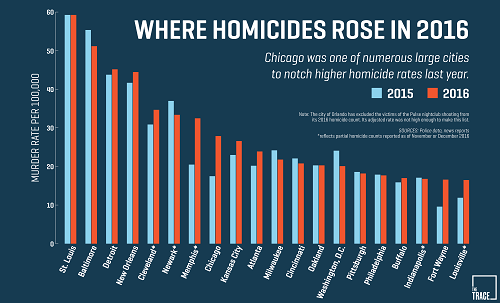New Government Survey: Homicide statistics trending upward across U.S.
 Although more than a few decidedly liberal-left Democrats holding offices in all levels of government — towns, cities, counties, states and national — claim that violent crime numbers are falling especially homicides, according to a study by the U.S. Justice Department’s National Institute of Justice released this month (November 2017) U.S. homicide rates rose substantially in 2015 and 2016.
Although more than a few decidedly liberal-left Democrats holding offices in all levels of government — towns, cities, counties, states and national — claim that violent crime numbers are falling especially homicides, according to a study by the U.S. Justice Department’s National Institute of Justice released this month (November 2017) U.S. homicide rates rose substantially in 2015 and 2016.
According to the FBI’s Uniform Crime Reporting (UCR) Program, 15,696 criminal homicides took place in the United States in 2015 — 1,532 more than during the previous year. The homicide rate rose from 4.4 to 4.9 homicides per 100,000 population from 2014 to 2015, an 11.4 percent increase and the largest one-year percentage rise in the U.S. homicide rate since 1968. In cities with 250,000 or more residents, the focus of the current NIJ report, homicides rose by 15.2 percent between 2014 and 2015.
By any reasonable standard, these are noteworthy increases, especially because they involve the most serious and reliably measured criminal offense. Homicide continued to increase in 2016. The nationwide homicide rate rose to 5.3 homicides per 100,000 population, an increase of 8.2 percent over 2015. The number of homicides in the big cities increased by 10.8 percent between 2015 and 2016.
“I’m not surprised by what we’re seeing in the nation’s crime statistics. After eight-years under Barack Obama, a President of the United States (POTUS) that disliked law enforcement officers more than he disliked criminals, terrorists and other miscreants,” said a former NYPD detective.
 “Obama and his underlings cynically kept encouraging the racial divide by pitting blacks against whites, Latinos and blacks against cops, Christians against Muslims, etc., all the while wrapping themselves up in garments of righteousness,” said Det. Sidney Franes, an African American who was one of the first blacks to serve in the U.S. Marines at the end of World War II.
“Obama and his underlings cynically kept encouraging the racial divide by pitting blacks against whites, Latinos and blacks against cops, Christians against Muslims, etc., all the while wrapping themselves up in garments of righteousness,” said Det. Sidney Franes, an African American who was one of the first blacks to serve in the U.S. Marines at the end of World War II.
The DOJ report revealed that increases were much larger than was typical of yearly homicide fluctuations over the past several decades, so they merit close attention. This news analysis extends a previous analysis by documenting the homicide rise in 2015 with more complete data and presenting data for large cities in 2016.
The DOJ study then considers two explanations for the recent homicide increase. The first explanation ties the increase to the expansion of illicit drug markets resulting from the heroin and synthetic opioid epidemic in the United States. The second explanation is the widely referenced Ferguson effect on crime rates, which attributes the homicide increase to reduced proactive policing, community alienation from the police, or both
Big-city homicides rose in 2015 and again in 2016, although not all cities experienced a large increase, and homicides fell in some cities. We consider two explanations of the homicide rise as guides for future research: (1) expansion in illicit drug markets brought about by the heroin and synthetic opioid epidemic and (2) widely referenced “Ferguson effects” resulting in de-policing, compromised police legitimacy, or both.
Larger increases in drug-related homicides than in other types of homicide provide preliminary evidence that expansions in illicit drug markets contributed to the overall homicide rise. The current drug epidemic is disproportionately concentrated in the white population, and homicides have increased among whites as well as among African Americans and Hispanics.
“We surmise, therefore, that the drug epidemic may have had an especially strong influence on the rise in homicide rates among whites. Current evidence that links de-policing to the homicide rise is mixed at best. Surveys of police reveal widespread concerns about increased police-community tensions and reductions in proactive policing in the aftermath of widely publicized deadly encounters between the police and African-Americans,” said the study’s researchers.
 Increases in homicide followed decreases in arrests in Baltimore and Chicago, although it is not known whether the same was true in other cities. Nationwide, arrest-offense ratios and arrest clearance rates decreased in 2015, but they had been declining for several years when homicide rates were falling. The extent of de-policing and its possible connection to the recent homicide rise remain open research questions.
Increases in homicide followed decreases in arrests in Baltimore and Chicago, although it is not known whether the same was true in other cities. Nationwide, arrest-offense ratios and arrest clearance rates decreased in 2015, but they had been declining for several years when homicide rates were falling. The extent of de-policing and its possible connection to the recent homicide rise remain open research questions.
Survey evidence reveals greater discontent with the police among African-Americans than among whites. Alienation from the police can result in a decreased willingness to contact them when a crime occurs or to cooperate in police investigations and, some studies suggest, an increase in criminal behavior.
One study has shown that calls for police service fell after a controversial violent encounter between the police and an unarmed African American in Milwaukee. The reduction in calls for service was greater in African-American neighborhoods than in other neighborhoods. The rate at which the police are contacted is only one of several indicators needed to measure any connection between diminished police legitimacy and the recent rise in homicides.


